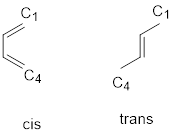
(a)
Interpretation:
The diene and dienophile from the given compounds has to be predicted.
Concept Introduction:
Diels-Alder reaction:
A conjugated diene reacts with a compound containing a carbon-carbon double bond. It is a cycloaddition reaction, where two reactants form a cyclic product.
Conformation of Diene:
S-cis Conformer: The double bonds are cis about the single bond (s stands for single), in an s-cis conformer.
S-trans Conformer: The double bonds are trans- about the single bond (s stands for single) in an s-trans conformer.
Condition for Diels-Alder reaction:
The conjugate diene must be in an s-cis conformation because when it is in an S-trans conformation, C-1 and C-4 are too far apart to react with the dienophile in a concerted reaction.

(b)
Interpretation:
The diene and dienophile from the given compounds has to be predicted.
Concept Introduction:
Diels-Alder reaction:
A conjugated diene reacts with a compound containing a carbon-carbon double bond. It is a cycloaddition reaction, where two reactants form a cyclic product.
Conformation of Diene:
S-Cis Conformer: The double bonds are cis about the single bond (s stands for single), in an s-cis conformer.
S-trans Conformer: The double bonds are trans- about the single bond (s stands for single) in an s-trans conformer.
Condition for Diels-Alder reaction:
The conjugate diene must be in an s-cis conformation because when it is in an S-trans conformation, C-1 and C-4 are too far apart to react with the dienophile in a concerted reaction.

(c)
Interpretation:
The diene and dienophile from the given compounds have to be predicted.
Concept Introduction:
Diels-Alder reaction:
A conjugated diene reacts with a compound containing a carbon-carbon double bond. It is a cycloaddition reaction, where two reactants form a cyclic product.
Conformation of Diene:
S-Cis Conformer: The double bonds are cis about the single bond (s stands for single), in an s-cis conformer.
S-trans Conformer: The double bonds are trans- about the single bond (s stands for single) in an s-trans conformer.
Condition for Diels-Alder reaction:
The conjugate diene must be in an s-cis conformation because when it is in an S-trans conformation, C-1 and C-4 are too far apart to react with the dienophile in a concerted reaction.

Want to see the full answer?
Check out a sample textbook solution
Chapter 7 Solutions
EP ESSENTIAL ORG.CHEM.-MOD.MASTERING
- Curved arrows are used to illustrate the flow of electrons. Using the provided starting and product structures, draw the curved electrons-pushing arrows for the following reaction or mechanistic step(s).arrow_forwardCurved arrows are used to illustrate the flow of electrons. Using the provided starting and product structures, draw the curved electron-pushing arrows for the following reaction or mechanistic step(s). Be sure to account for all bond-breaking and bond-making steps. I I I H Select to Add Arrows HCI, CH3CH2OHarrow_forwardCurved arrows are used to illustrate the flow of electrons. Use the reaction conditions provided and the follow the arrows to draw the intermediate and product in this reaction or mechanistic step(s).arrow_forward
- Curved arrows are used to illustrate the flow of electrons. Use the reaction conditions provided and follow the curved arrows to draw the intermediates and product of the following reaction or mechanistic step(s).arrow_forwardCurved arrows are used to illustrate the flow of electrons. Use the reaction conditions provided and follow the arrows to draw the intermediate and the product in this reaction or mechanistic step(s).arrow_forwardLook at the following pairs of structures carefully to identify them as representing a) completely different compounds, b) compounds that are structural isomers of each other, c) compounds that are geometric isomers of each other, d) conformers of the same compound (part of structure rotated around a single bond) or e) the same structure.arrow_forward
- Given 10.0 g of NaOH, what volume of a 0.100 M solution of H2SO4 would be required to exactly react all the NaOH?arrow_forward3.50 g of Li are combined with 3.50 g of N2. What is the maximum mass of Li3N that can be produced? 6 Li + N2 ---> 2 Li3Narrow_forward3.50 g of Li are combined with 3.50 g of N2. What is the maximum mass of Li3N that can be produced? 6 Li + N2 ---> 2 Li3Narrow_forward
- Concentration Trial1 Concentration of iodide solution (mA) 255.8 Concentration of thiosulfate solution (mM) 47.0 Concentration of hydrogen peroxide solution (mM) 110.1 Temperature of iodide solution ('C) 25.0 Volume of iodide solution (1) used (mL) 10.0 Volume of thiosulfate solution (5:03) used (mL) Volume of DI water used (mL) Volume of hydrogen peroxide solution (H₂O₂) used (mL) 1.0 2.5 7.5 Time (s) 16.9 Dark blue Observations Initial concentration of iodide in reaction (mA) Initial concentration of thiosulfate in reaction (mA) Initial concentration of hydrogen peroxide in reaction (mA) Initial Rate (mA's)arrow_forwardDraw the condensed or line-angle structure for an alkene with the formula C5H10. Note: Avoid selecting cis-/trans- isomers in this exercise. Draw two additional condensed or line-angle structures for alkenes with the formula C5H10. Record the name of the isomers in Data Table 1. Repeat steps for 2 cyclic isomers of C5H10arrow_forwardExplain why the following names of the structures are incorrect. CH2CH3 CH3-C=CH-CH2-CH3 a. 2-ethyl-2-pentene CH3 | CH3-CH-CH2-CH=CH2 b. 2-methyl-4-pentenearrow_forward
 Organic ChemistryChemistryISBN:9781305580350Author:William H. Brown, Brent L. Iverson, Eric Anslyn, Christopher S. FootePublisher:Cengage Learning
Organic ChemistryChemistryISBN:9781305580350Author:William H. Brown, Brent L. Iverson, Eric Anslyn, Christopher S. FootePublisher:Cengage Learning

